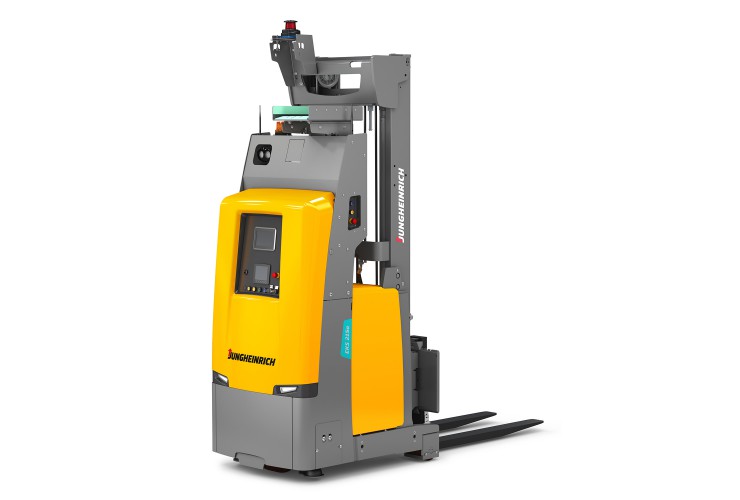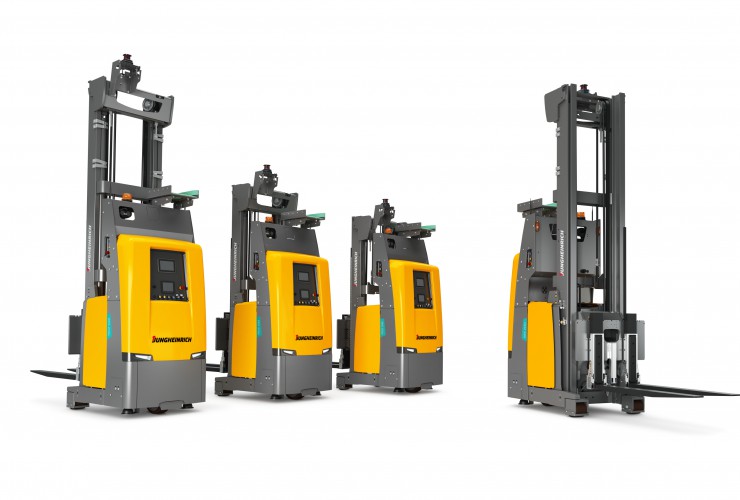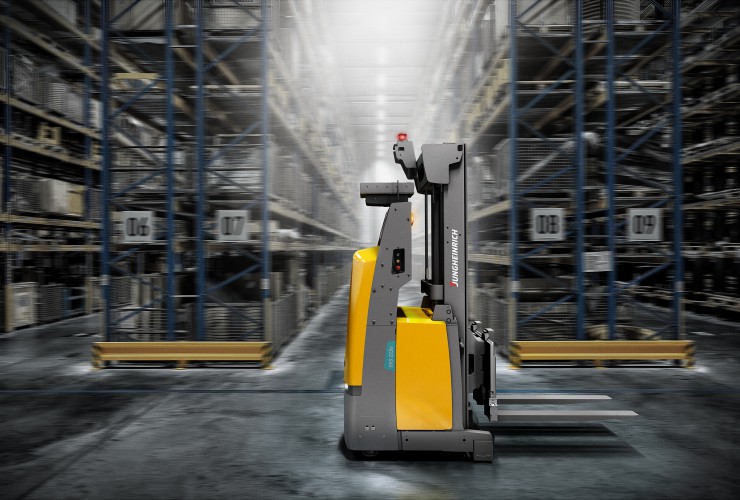IFOY Patronage
IFOY Sponsor
EKS 215a
Jungheinrich
IFOY-Kategorie
Automated Guided Vehicle (AGV / AMR)
Zusammenfassung
Der EKS 215a ist das erste Fahrerlose Transportfahrzeug (FTF) von Jungheinrich, das für einen reinen automatisierten Einsatz entwickelt wurde. Das integrierte Sicherheitskonzept und der kleine physische und virtuelle Fußabdruck des Fahrzeugs ermöglichen einen reibungslosen Einsatz in Bestandsumgebungen, in denen auch manueller Verkehr herrscht. Das 24-Volt-Konzept mit Automatikladen stellt einen effizienten Mehrschicht-Betrieb sicher. Für eine intuitive Bedienung sorgt das benutzerfreundliche Touch-Display.
Beschreibung
Der EKS 215a wird zur Automatisierung von Transporten sowohl in Logistik als auch Produktion eingesetzt. Mit seinen freitragenden Gabeln ist das FTF die perfekte Wahl für Paletten oder Sonderladungsträger. Zudem können auch nicht-unterfahrbare Stationen mit dem EKS 215a automatisiert werden. Die Aufgabe des innerbetrieblichen Transports von Ladehilfsmitteln im Mischbetrieb mit manuellen Fahrzeugen oder Personen meistert der kompakte EKS 215a durch den geringen Platzbedarf mit Bravour. Durch seine hohe Hubhöhe bis auf sechs Meter und seine gleichzeitig hohe Resttragfähigkeit von bis zu 700 Kilogramm kann der EKS 215a zum Einlagern in Regalen genutzt werden. Es steht eine große Auswahl an Masttypen je nach Einsatzfall und Umgebungsbedingung zur Verfügung. Das neue, effiziente 24-Volt Energiekonzept mit Lithium-Ionen-Batterie und Automatik-Ladefunktion sorgt für maximale Flexibilität auch im Mehrschicht-Betrieb.
Sicherheit stand bei der Entwicklung des FTFs im Fokus: Das Sicherheitskonzept mit integrierten Personenschutzscannern, sowie die neue Lasterkennung entsprechen der DIN ISO 3691-4. Der sichere Transport ist jederzeit gewährleistet.
Um eine intuitive Bedienung sicherzustellen, wurde im Bedienkonzept ein neues Display integriert. Der Mitarbeiter kann auf einen Blick sehen, welcher nächster Schritt geplant ist. Auch die Fehlerdiagnose und –behebung ist einfach und transparent auf dem Display möglich.
Bewerbungsdaten
Innovation
Kompaktes Design:
• Dank maximaler Wendigkeit eignet sich das Fahrzeug perfekt für schmale Einfahrten
• Geringer Platzbedarf im Layout durch die extrem kompakten Fahrzeugdimensionen
Intelligente Sicherheitsfunktionen:
• Schutz vor Beschädigungen durch integrierte Sicherheitssensoren unter dem Fahrzeugrahmen
• Smartes Sicherheitskonzept mit feingliedrigen Schutz- und Warnfeldern für eine effiziente Layoutplanung
• Sicherer Transport durch Lasterkennung mit Performance Level
Intuitiv bedienbares Interface:
• Eindeutige Statusanzeige des Fahrzeugs auf einen Blick durch neues 7-Zoll-Display mit Touch-Funktion
• Interaktionsmöglichkeiten am Fahrzeug: Es kann manuell zum Laden geschickt werden; Blocking kann gelöst werden
• Erleichtertes Trouble-Shooting: einfache Fehlerbeschreibung und Handlungsempfehlungen zur effizienten Fehlerbehebung
Erweitertes Hubgerüst-Raster und erhöhte Resttragfähigkeit:
• Große Auswahl an Hubgerüsten zur flexiblen Anpassung an das Lagerlayout
• Höhere Nutzlast bei kleinerer Stellfläche durch die Erhöhung der Resttragfähigkeit
Marktrelevanz
Die Automatisierung von manuellen logistischen Prozessen ist aufgrund des Kostendrucks und fehlender Fachkräfte eine immer wichtiger werdende branchen- und unternehmensübergreifende Aufgabe. Mit dem neuen, kompakten EKS 215a können Prozesse in bestehender Infrastruktur automatisiert werden, auch in engen Hallen und in Produktionsumgebung. Durch die gleichzeitig gesteigerte Resttragfähigkeit gibt es weniger Limitationen beim Einlagern von Ladehilfsmitteln in hohen Höhen. Das FTF kann optimal dort eingesetzt werden, wo heute Gegengewichtsstapler oder auch Schubmaststapler arbeiten.
Hauptvorteile für den Kunden
Kompakt, sicher und einfach zu betreiben:
• Vielseitiges, kompaktes FTF für den sicheren Einsatz im Mischbetrieb
• Hubhöhe bis zu 6 Metern und freitragende Gabeln für hohe Flexibilität
• Einfache Bedienung mit intuitiven Interaktionsmöglichkeiten
• Wirtschaftlicher 24/7-Betrieb dank Lithium-Ionen-Technologie mit Automatikladen
• Auf Serienkomponenten basierendes FTF zur flexiblen Automatisierung – auch auf kleinstem Raum
• Sicherheitskonzept: integrierte Scanner, sicherer Lasttransport und adaptives Schutzfeldkonzept
Technische Daten
Video: Automation with the smart allrounder: Jungheinrich EKSa.
IFOY Test
| Name | Jungheinrich, EKS 215a |
| Category | AGV / AMR |
| Date of Test | 17.-23. März 2022 |
Testbericht
Das „a“ im Produktnamen des EKS 215a steht für autonom. Wie Jungheinrich angibt, ist sein neuestes AGV-Produkt, das freitragende Hochhub-FTF EKS 215a, das erste fahrerlose Transportfahrzeug (FTF) seiner Klasse, das ausschließlich für den Automatikbetrieb entwickelt worden ist. Ganz hilflos ist das Gerät allerdings nicht, falls eine Fehlfunktion es einmal zum Stehen bringen sollte: Per Schlüsselschalter kann das Gerät auf Handbetrieb mit Notfall-Bedienpanel umgestellt werden. Damit sind grundsätzlich alle Funktionen möglich, nur etwas langsamer.
Die Test-Installation des ersten „echten“ autonomen Hochhubstaplers von Jungheinrich in der Dortmunder Messehalle ist innerhalb von wenigen Stunden erledigt. Das autonome Hochhubfahrzeug EKS 215a, das problemlos zum Laufen gebracht wird, kann Paletten bis zu 6 Metern mit einer Resttragfähigkeit bis 700 Kilogramm ein- und auslagern. Im unteren Regalbereich, bis etwa 2 Meter, schafft das AGV Paletten oder Sonderladungsträger mit 1.500 Kilogramm. Als echter Autonomer ist das Gerät sehr klein konstruiert: Auf 3,5 Metern kann damit gedreht und das Regal beidseitig bedient werden. Damit ist der freitragende automatische Kommissionierstapler, der Ende 2021 in den Verkauf gegangen ist, klein, kompakt, schnell und wendig.
Wenn das mit einem mobilen Laser-Personenschutzscanner aus dem Hause Sick ausgestattete Fahrzeug einmal keinen Fahrauftrag hat und die Lithium-Ionen-Batterie nicht voll ist, wird im Echtbetrieb zwischengeladen – das geht auch minutenweise, per grüner Kontaktplatte überkopf. Interessant ist diese Möglichkeit insbesondere in Arbeitssituationen, in denen man nicht genau weiß, wann der Stapler das nächste Mal fahren muss. Das 24-Volt-Konzept mit Automatikladen stellt einen effizienten Mehrschichtbetrieb sicher. Für eine intuitive Bedienung sorgt das benutzerfreundliche Touchdisplay.
Gesteuert wird das AGV von einem übergeordneten System: je nach Anbindung zum Warehouse-Management-System (WMS) des Kunden oder als Stand-alone-System von Jungheinrich mittels sensorüberwachter Stellplätze. Dann jagt das Ladegerät 300 Ampere in die Batterie. Von 25 auf 50 Prozent ist der Akku so in etwa 10 Minuten aufgeladen, ihn bis zu 80 Prozent zu pushen dauert etwa 30 Minuten. Ohne Anbindung an ein Kunden-WMS wie beispielsweise von SAP bekommt der Kunde eine Benutzeroberfläche mit Drop-down-Menü von Jungheinrich gestellt. Diese Oberfläche mit Web-Browser gibt es auch fürs Handy oder Tablet. Allerdings kann der Kunden schon aus Produkthaftungsgründen darin nicht herumprogrammieren.
Im Unterschied zum Schubmaststapler können mit dem EKS 215a mit seinen freitragenden Gabeln auch nicht-unterfahrbare Stationen angefahren und automatisiert werden. Den innerbetrieblichen Transport von Ladehilfsmitteln im Mischbetrieb mit manuell gesteuerten Fahrzeugen oder Personen meistert der Neue durch seinen geringen Platzbedarf mit Bravour. Je nach Einsatzfall steht eine große Auswahl an Masttypen zur Verfügung. Übrigens: Das Hochhub-FTF lässt sich via Jungheinrich Logistik-Interface auch einfach an ERP-Systeme anbinden.
IFOY Testfazit
Es wird immer wichtiger, manuelle logistische Prozesse zu automatisieren. Mit dem neuen EKS 215a können Prozesse in bestehenden Infrastrukturen automatisiert werden, auch im Mischbetrieb mit manuellen Fahrzeugen oder Personen. Das in Jungheinrich-Manier erstklassig verarbeitete Gerät verspricht dank Lithium-Ionen-Energieversorgung und automatischem Laden einen wirtschaftlichen 24/7-Betrieb – auch auf kleinstem Raum. Der integrierte Scanner und das adaptive Schutzfeldkonzept tun ihr Übriges, um den EKS 215a zu einer Empfehlung des Testers zu machen.
IFOY Innovation Check
IFOY Innovation Check
Marktrelevanz
Das Fahrerlose Transportfahrzeug (FTF) EKS 215a von Jungheinrich repräsentiert eine wesentliche Weiterentwicklung in Richtung Kompaktheit bei hohen Leistungsdaten im Bereich automatisierter Logistik. Dadurch werden für den Markt weitere Möglichkeiten geschaffen, herkömmliche Ein- und Auslagerungsprozesse auch bei engen Platzverhältnissen zu automatisieren. Beispielsweise sind Lager, in denen Schubmaststapler zum Einsatz kommen, kein Hindernis für dieses kompakte FTF. Der EKS 215a bedient damit den steigenden Bedarf an Automatisierung aufgrund Fachkräftemangel und Einsparbedarf.
Kundennutzen
Die Kunden profitieren von extrem kompakten Dimensionen bei einer möglichen Hubhöhe bis 6 m und einer Resttragfähigkeit von 700 kg in dieser Höhe, was bei FTF mit freitragenden Gabeln einen Benchmark darstellt. Es ist darüber hinaus eine große Robustheit zu erwarten, da beim EKS 215a auf bewährte Komponenten der Flurförderzeuge aus dem Hause Jungheinrich zurückgegriffen wurde und nicht alle Baugruppen gänzlich neu entwickelt werden mussten. Das Steuerungssystem sowie die Fehleranalyse sind über das Bedienkonzept sehr nutzerfreundlich realisiert worden.
Neuheitsgrad
Neben der Kombination aus geringer Baugröße und den hohen Leistungsdaten sind die Applikation der Sicherheitssensoren, geschützt unter dem Fahrzeug, sowie das benutzerfreundlicher Bedieninterface als wesentliche Innovationen einzuschätzen.
Funktionalität / Art der Umsetzung
Das EKS 215a beeindruckt durch sehr gute qualitative Umsetzung. Es wurden keine experimentellen Kompromisse eingegangen und auf bewährte Komponenten gesetzt. Eine genaue Positionierung der Beladung in großen Hubhöhen wird durch den Reflektor-Scanner sichergestellt und stellt ein Beispiel für erwarteten fehlerarmen Betrieb dar.
Fazit
Eine würdige IFOY Nominierung, die sich zu den Besten zählen darf.
|
Marktrelevanz |
++ |
|
Kundennutzen |
+ |
|
Neuheitsgrad |
+ |
|
Funktionalität / Art der Umsetzung |
++ |
|
++ sehr gut / + gut / Ø ausgeglichen / - weniger / - - nicht vorhanden |
|
EKS 215a
Jungheinrich
IFOY category
Automated Guided Vehicle (AGV / AMR)
Summary
The EKS 215a is Jungheinrich's first Automated Guided Vehicle (AGV) purely designed for automated operation. The integrated safety concept and the truck's small physical and virtual footprint enable smooth operation in inventory environments in which manual traffic is also present. The 24-V energy concept ensures efficient multi-shift operation. Intuitive handling is ensured by the user-friendly touch display.
Description
The EKS 215a is used to automate transports in both logistics and production. With its cantilever forks, the AGV is the perfect choice for pallets or special load carriers. In addition, stations that are not accessible from underneath can also be automated with the EKS 215a. The compact EKS 215a masters the task of in-house transport of load carriers in mixed operation with manual vehicles or persons effortlessly thanks to its small footprint. Due to its high lifting height up to 6 metres and its simultaneously high residual load capacity of up to 700 kilograms, the EKS 215a can be used for racking. A wide range of mast types is available depending on the application and environmental conditions. The new, efficient 24-volt energy concept with lithium-ion battery and automatic charging function ensures maximum flexibility even in multi-shift operation.
Safety was a key focus in the development of the AGV: The safety concept with integrated personal protection scanners, as well as the new load detection system, comply with DIN ISO 3691-4. Safe transport is guaranteed at all times.
To ensure intuitive operation, a new display has been integrated into the operating concept. The employee can see at a glance which next step is planned. Diagnosis and troubleshooting can also be carried out easily and transparently on the display.
Entry Data
Innovation
Compact design:
• Thanks to maximum maneuverability, the vehicle is perfect for narrow driveways
• Low space requirement in the layout due to the extremely compact vehicle dimensions
Intelligent safety functions:
• Protection against damage thanks to integrated safety sensors under the vehicle frame
• Smart safety concept with fine-grained protection and warning fields for efficient layout planning
• Safe transport due to load detection system with performance level
Intuitive user interface:
• Clear status display of the vehicle at a glance thanks to new 7-inch display with touch function
• Interaction options on the vehicle: it can be sent manually for loading; blocking can be resolved
• Facilitated trouble shooting: error description and recommended actions for efficient troubleshooting
Extended mast grid and increased residual capacity:
• Large selection of masts for flexible adaptation to the warehouse layout
• Higher payload with smaller footprint due to increased residual capacity
Marktet relevance
The automation of manual logistical processes is an increasingly important cross-industry and cross-company task due to cost pressure and a lack of skilled workers. With the new, compact EKS 215a, processes can be automated in existing infrastructure: even in narrow halls and busy production environments. Thanks to the simultaneously increased residual load capacity, there are fewer limitations when racking loads at high heights. The AGV can be optimally used where counterbalanced trucks or reach trucks are currently operated manually.
Main customer benefits
Compactness, safeness and high ease-of-use:
• Versatile, compact AGV for safe operation in mixed applications
• Lifting height up to 6 meters and cantilever forks for high flexibility
• Simple operation with intuitive interaction options
• Economical 24/7 operation thanks to lithium-ion technology with automatic charging
• AGV based on series components for flexible automation – even in the smallest of spaces
• Safety concept: integrated scanners, safe load transport and adaptive protective field concept
Technical data
Video: Automation with the smart allrounder: Jungheinrich EKSa.
IFOY Test
| Name | Jungheinrich, EKS 215a |
| Category | AGV / AMR |
| Date of Test | March 18 to March 23, 2022 |
Test Report
The "a" in the product name of the EKS 215a stands for autonomous. As Jungheinrich states, its latest AGV product, the high-lift AGV EKS 215a, is the first autonomous guided vehicle (AGV) in its class that has been developed exclusively for automatic operation. However, the truck is not completely helpless if a malfunction should ever bring it to a halt: the truck can be switched to manual operation with an emergency control panel by means of a key switch. In this way, all functions are basically possible, only somewhat slower.
The test installation of the first "real" autonomous high-lift truck from Jungheinrich in the Dortmund exhibition hall is completed within a few hours. The EKS 215a autonomous high-lift truck, which is made to run without any problems, can store and retrieve pallets up to 6 metres with a residual load capacity of up to 700 kilograms. In the lower racking area, up to about 2 metres, the AGV can handle pallets or special load carriers weighing 1,500 kilogrammes. As a true autonomous truck, it is designed to be very small: At 3.5 metres, it can be turned and the racking can be served from both sides. This makes the self-supporting automatic order picker, which went on sale at the end of 2021, small, compact, fast and manoeuvrable.
If the vehicle, which is equipped with a mobile laser personal protection scanner from Sick, does not have a driving job and the lithium-ion battery is not full, it is temporarily charged in real operation - this is also possible by the minute, via a green contact plate overhead. This option is particularly interesting in work situations where you don't know exactly when the truck will have to drive the next time. The 24-volt concept with automatic loading ensures efficient multi-shift operation. The user-friendly touch display ensures intuitive operation.
The AGV is controlled by a higher-level system: depending on the connection to the customer's warehouse management system (WMS) or as a stand-alone system from Jungheinrich using sensor-monitored bays. Then the charger chases 300 amps into the battery. This way, the battery is charged from 25 to 50 per cent in about 10 minutes; pushing it up to 80 percent takes about 30 minutes. Without a connection to a customer WMS such as SAP, the customer is provided with a user interface with a drop-down menu from Jungheinrich. This interface with a web browser is also available for mobile phones or tablets. However, for product liability reasons, the customer cannot program around in it.
In contrast to the reach truck, the EKS 215a with its cantilever forks can also be used to approach and automate stations that are not accessible from below. The new truck masters the in-house transport of loading aids in mixed operation with manually controlled vehicles or persons with flying colours thanks to its small footprint. Depending on the application, a wide range of mast types is available. By the way: the high-lift AGV can also be easily connected to ERP systems via the Jungheinrich logistics interface.
IFOY Test Verdict
It is becoming increasingly important to automate manual logistics processes. With the new EKS 215a, processes in existing infrastructures can be automated, even in mixed operation with manual trucks or people. Thanks to its lithium-ion power supply and automatic charging, the device, which is first-class in Jungheinrich style, promises economical 24/7 operation - even in the smallest of spaces. The integrated scanner and the adaptive protective field concept do the rest to make the EKS 215a a recommendation from the tester.
IFOY Innovation Check
IFOY Innovation Check
Market Relevance
The EKS 215a automated guided vehicle (AGV) from Jungheinrich represents a significant refinement towards compactness with high performance data in the field of automated logistics. This creates further possibilities for the market to automate conventional storage and retrieval processes even in tight spaces. For example, warehouses where reach trucks are used are no obstacle for this compact AGV. The EKS 215a thus serves the increasing demand for automation due to a lack of skilled workers and the need to reduce costs.
Customer Benefit
Customers profit from extremely compact dimensions with a possible lift height of up to 6 metres and a residual load capacity of 700 kilograms at this height, which is a benchmark for AGVs with cantilever forks. Furthermore, a high degree of robustness can be expected, as the EKS 215a uses proven components of Jungheinrich industrial trucks and not all assemblies had to be completely newly developed. The control system as well as the troubleshooting have been realised in a very user-friendly way via the operating concept.
Novelty
In addition to the combination of small size and high performance data, the application of the safety sensors, protected under the vehicle, as well as the user-friendly operating interface are considered to be significant innovations.
Functionality / Type of Implementation
The EKS 215a impresses with its very good quality implementation. No experimental compromises were made and reliance was placed on proven components. Precise positioning of the load at high lift heights is ensured by the reflector scanner and represents an example of expected low-fault operation.s.
Verdict
A worthy IFOY nominated product that can count itself among the best.
|
Market Relevance |
++ |
|
Customer Benefit |
+ |
|
Novelty |
+ |
|
Functionality / Type of i Implementation |
++ |
|
++ very good / + good / Ø balanced / - less / - - not available |
|

















